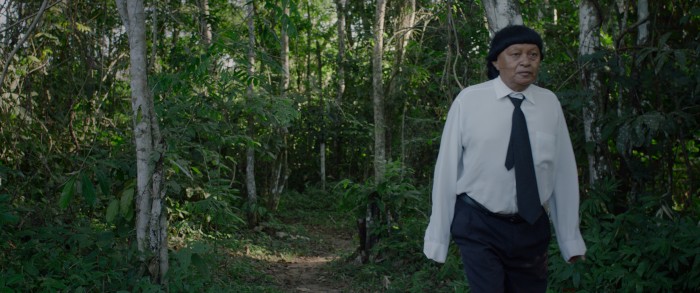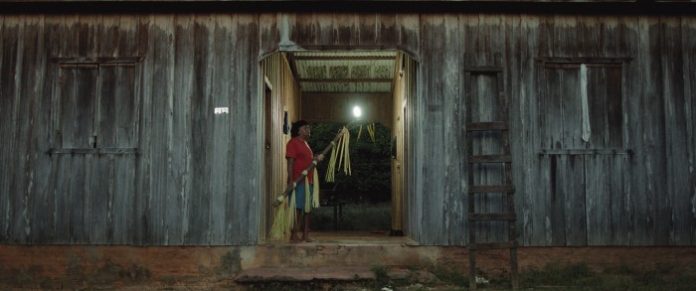(THIS ARTICLE IS MACHINE TRANSLATED by Google from Norwegian)
«Ethnocide is the systematic destruction of ways of living and thinking different from those who lead this venture of destruction. In sum, while genocide assassinates people in their bodies, ethnocide kills them in their souls. " – Pierre Clastres
The opening scene in Luiz Bolognesi's sensitive documentary Ex-Shaman (2018), which had its world premiere during the Berlin International Film Festival this year, consists of beautiful archival footage filmed from above of the territory of Indigenous tribe Paiter Surui in Brazil in 1969. We see lush green jungle stretching to the horizon.
The quote above from the French anthropologist Clastres sets the tone for the film as we watch grasshoppers on the ground and then footage inside the jungle, with indigenous people emerging from the trees and undergrowth. They feel at home in their surroundings, where they live as they have done for thousands of years.
 People from the "civilized world" greet them, give them gifts: hats and eye-mugs. It is a picture from happy and peaceful days.
People from the "civilized world" greet them, give them gifts: hats and eye-mugs. It is a picture from happy and peaceful days.
Then we jump 47 years ahead in time to the same place, and the first pictures of wooden sheds with tin roofs and telephone wires and high-voltage masts appear shocking and shocking.
Inside one of the cabins, a man is sitting under a mosquito net while an electric fan buzzes nearby, and another man arrives on a motorcycle. Both are dressed in western clothes; Gone are the penis sheaths and piercings in the nose, arches and arrows – the way of life that lasted for thousands of years.
From the shaman to the aspirin
We meet Perpera, the ex-shaman of the film title. The road to confront what he (and his people) have lost, begins when two books on research on tribal traditions are presented to them.
If Western customs have ruined the traditional way of life of his tribe, then perhaps the books can provide a way out of the situation caused by the so-called "progress"?
"A shaman used to be in the spotlight… People used to seek out the shaman, now they take aspirin."
Perpera
Perpera and the younger man (who we later know is his nephew) browse through old photographs.
"A shaman used to be in the spotlight… People used to seek out the shaman, now they take aspirin."
Director Bolognesi builds the excitement as he portrays Perpera while doing his business – getting shuttled into town, talking to a cashier with partial use of sign language, and pushing a cart in a supermarket. At the same time, images from past Kodachrome recordings pass through the mind of the spectator.
How did that happen? What happened to this man – an ex-shaman who now seems lost between these antiseptic shelves in the supermarket?
Forgotten traditions
Perpera's path to shamanism seems to have ended, when we learn that he has converted to evangelical Christianity. Yet, when fishing with a teenage boy who asks him about the river spirit and the shaman's relationship with the spiritual world, Perpera begins to return to his old identity.
Can Perpera become shaman again?

"No, after the priests said that shamans come from hell, no one wanted to talk to me. They ignored me… They started talking to me again only after I started going to church. "
Perpera, who has been a Christian for a long time, opens the door to the village church, where an elderly, white priest explains to a visitor – with no demonstrable irony – that: "Here our lives are full of the Holy Ghost."
The extent to which the old customs have been lost – despite attempts to keep some traditions and crafts alive – also becomes clear through the way Bolognesi chooses his recordings. We see villagers taking rifles with them when looking for illegal loggers; a young boy who overhears the hustle and bustle of his uncles about learning how to paint plants – his eyes never rise from the screen of the iPad in his hands…
What happened to this man – an ex-shaman who now seems lost between these antiseptic shelves in the supermarket?
Perpera's inner struggle becomes particularly evident when ants cause a short circuit in the electrical wiring in his cabin, and it suddenly becomes dark.
"I must have light… I can not sleep in the dark," he says.
"The forest spirits are beating me up, they're angry because of the church."
The shaman returns
As a mobile pharmacy comes to the village, and the villagers come to take syringes and get new prescriptions, what plagues Perpera – forest spirits or his own, inner contradictions – is evident in his face as he views the scene from a church window.
 Finally, there is an emergency that brings Perpera back to the road he had left. A village woman is bitten by a poisonous snake and is brought to the hospital in haste and haste – her relatives plead with Perpera to do something. The ex-shaman asks them to follow a special diet, find and kill the snake, and even he starts seeking support from the forest spirits.
Finally, there is an emergency that brings Perpera back to the road he had left. A village woman is bitten by a poisonous snake and is brought to the hospital in haste and haste – her relatives plead with Perpera to do something. The ex-shaman asks them to follow a special diet, find and kill the snake, and even he starts seeking support from the forest spirits.
"To fight the enemy spirits, we must act like a great Paiter warrior," Perpera says, asking for help in creating a spiritually powerful, healing flute, and raiding a huge ant wall suspected of harboring harmful spirits.
While claiming that thousands of years of tradition and faith are modernity superior, he finally comes to a synthesis. When the serpent's sacrifice returns, completely healed, he proclaims that "God's Atonement is complete."


